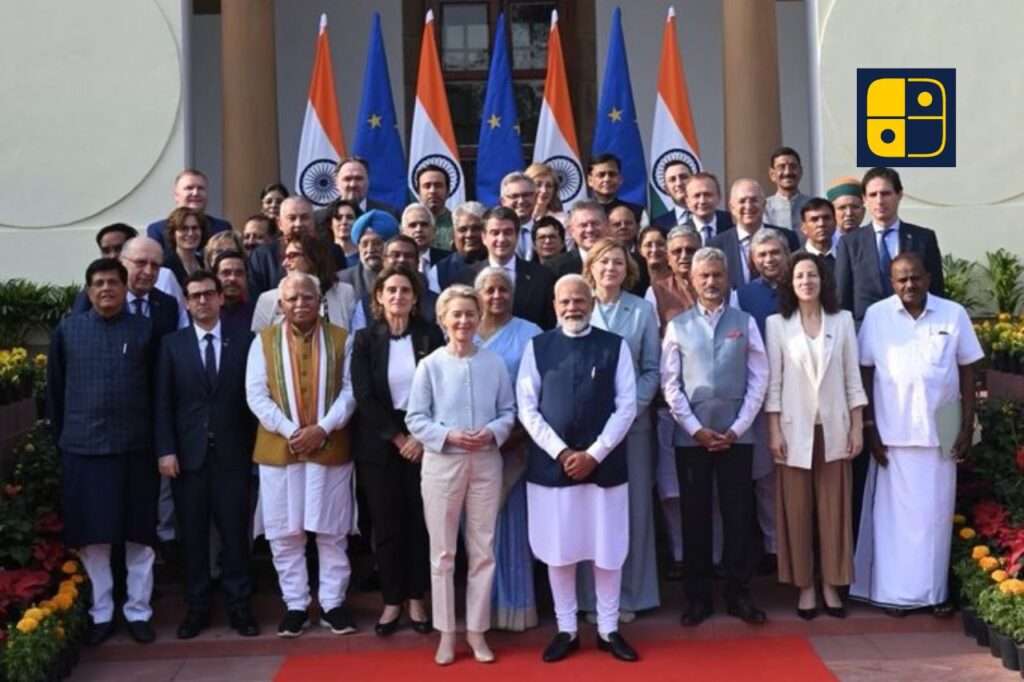“The EU-India FTA has shifted from a long-term aspiration to a near-term hedge against tariff shocks, supply-chain risk, and carbon border costs.”
Long Journey of a Stalled Agreement
The EU and India first launched their Broad-based Trade and Investment Agreement in 2007, only to stall by 2013 over gaps on market access and regulatory standards. Talks were formally relaunched after leaders agreed in May 2021 to resume negotiations alongside a separate pact on investment protection and a deal on geographical indications with rounds intensifying from mid-2022 onward.
Why the Urgency Now
Three forces converged: the sharp rise in U.S. protectionism and tariff uncertainty, the EU’s drive to diversify in the Indo-Pacific, and a bilateral trade base that has nearly doubled in a decade (the EU is India’s second-largest trading partner, ~€120 billion in goods trade in 2024). The current tariff turbulence has added urgency in Delhi to widen preferential access beyond the U.S. market.
What Brussels Wants, What Delhi Seeks
Substance matters. Brussels seeks steeper tariff cuts on cars and auto parts, medical devices, wine and spirits, and better disciplines on government procurement, sustainability, and rules of origin. Delhi prioritises wider access for textiles, pharma, steel and refined products, and crucially more predictable treatment for services and professionals. The EU’s Carbon Border Adjustment Mechanism looms in the background, effectively a carbon-linked levy on emissions-intensive imports; Indian negotiators want flexibilities and green-transition support so exporters are not priced out.
Tariff Impacts and Sectoral Stakes
Tariff effects would be tangible. Lower EU duties on autos and beverages are politically sensitive in India but could be phased; reciprocal cuts would ease entry for Indian labour-intensive goods where margins are thin amid global price competition. Services chapters, backed by mobility provisions, are the largest growth lever given India’s IT/ITeS strengths and the EU’s deep services market. For Europe, an ambitious deal secures a large, fast-growing market and reduces over-reliance on China, while anchoring supply-chain de-risking in pharma, chemicals, and green tech. Globally, a rules-based mega-deal between two heavyweight democracies would counter tariff wars by expanding a high-standard, non-U.S./non-China trade pillar.
Current Negotiations and Sticking Points
India and the European Union are intensifying negotiations in New Delhi this week, initiating the pivotal 13th round of the Free Trade Agreement (FTA) talks, with a clear aim to seal the agreement by year-end. European commissioners including Trade chief Maroš Šefčovič and Agriculture Commissioner Christoph Hansen have arrived in the capital for high-level engagements, signalling political urgency. With 11 out of 23 chapters already concluded covering areas such as digital trade, intellectual property, and dispute resolution the focus has now shifted sharply to outstanding issues like rules of origin, market access for dairy and alcohol, and environmental standards, all critical in bridging the remaining gap.
Lessons from the UK-India FTA
Spillovers from other deals matter. The UK-India FTA signed in July 2025 (pending ratification) will test how India sequences market opening in autos/alcohol and frames services mobility, a template Brussels is watching closely. If Delhi secures UK-style gains on services while pacing sensitive goods, an EU deal becomes more saleable at home.
Outlook and Global Significance
A commercially meaningful, phased FTA is plausible in 2025 if CBAM accommodations, autos/beverages tariff glide paths, and GI/IP health safeguards are balanced. The payoff, lower trade costs, greener and more diversified supply chains, and a stronger Global South-Europe corridor would be felt well beyond Delhi and Brussels.

